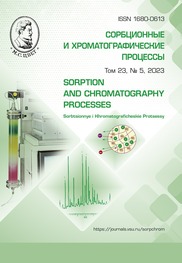Purification of aqueous solutions from As (III) and As (V) with the use of modified montmorillonite
Abstract
Arsenic is a toxic and carcinogenic element; pollution of natural waters with arsenic is a global problem. Inorganic As (III) compounds are known to be more toxic than inorganic As (V) compounds. Purification of water from As (III) and As (V) using adsorption materials based on clay minerals is of increasing interest today. In this study, we investigated the possibility of purifying aqueous solutions from As (III) and As (V) using composite sorbents created by modifying montmorillonite. Montmorillonite modified with Fe3O4 nanoparticles and a cationic surfactant, showed a better degree of extraction of As (III) and As (V) from aqueous solutions compared to other modifications. The extraction rate of As(III) and As(V) by montmorillonite modified with Fe3O4 nanoparticles and a cationic surfactant did not depend on the pH of the solution and was higher than 95%. Optimal conditions for the extraction of As (III) and As (V) from aqueous solutions have been established using montmorillonite modified with Fe3O4 nanoparticles and a cationic surfactant. It has been shown that in the presence of Fe(III) ions, the degree of extraction of As(III) and As(V) by montmorillonite modified Fe3O4 nanoparticles and a cationic surfactant, decreased to 69%. Cr(III) possess the highest influence on the degree of extraction of As (III) and As (V): the degree of recovery of As (III) and As (V) using montmorillonite modified with Fe3O4 nanoparticles and a cationic surfactant, in its presence decreases and amounts to 40 and 25%, respectively. Together with As (III) and As (V), Cu (II) was almost completely removed from the solution. Adsorption process of As(III) and As(V) on montmorillonite modified with Fe3O4 nanoparticles and a cationic surfactant is best described by the Langmuir model. The sorption capacity of modified montmorillonite for As (III) and As (V) was 9.9 mg/g and 7.6 mg/g, respectively.
Downloads
References
Senthil Rathi B., Senthil Kumar P. A review on sources, identification and treatment strategies for the removal of tox-ic arsenic from water system, J. Hazard. Mater. 202; 418: 126299. https://doi.org/10.1016/j.jhazmat.2021.126299
Mohan D., Pittman C.U. Arsenic removal from water/wastewater using adsorbents – a critical review, J. Hazard. Ma-ter. 2007; 142: 1-53. https://doi.org/10.1016/j.jhazmat.2007.01.006
Ungureanu G., Santos S., Boaventu-ra R., Botelho C. Arsenic and antimony in water and wastewater: Overview of removal techniques with special reference to lat-est advances in adsorption, J. Environ. Manage. 2015; 151: 326-342. https://doi.org/10.1016/
j.jenvman.2014.12.051
Manna S., Das P., Basak P., Sharma A. K., Singh V. K., Patel R. K., Pandey J. K., Ashokkumar V., Pugazhendhi A. Sepa-ration of pollutants from aqueous solution using nanoclay and its nanocomposites: A review, Chemosphere. 2021; 280: 30961. https://doi.org/10.1016/j.chemosphere.2021.130961
Kausor M. A., Gupta S. S., Bhattacharyya K. G., Chakrabortty D. Montmorillonite and modified montmoril-lonite as adsorbents for removal of water soluble organic dyes: A review on current status of the art, Inorg. Chem. 2022; 143: 109686. https://doi.org/10.1016/j.inoche.2022.109686
Ordinartsev D.P., Pechishcheva N.V., Estemirova S.Kh., Kim A.V., Shunyaev K.Yu. Removal of Cr (VI) from wastewater by modified montmorillonite in combination with zero-valent iron, Hydro-metallurgy. 2022; 208: 105813. https://doi.org/10.1016/j.hydromet.2021.
Anjum A., Datta M. Adsorptive Removal of Antimony (III) Using Modified Montmorillonite: A Study on Sorption Kinetics. J. Anal. Sci. Meth. Instrum., 2012; 2 (3): 167-175. https://doi.org/10.4236/jasmi.2012.23027
Urbano B. F., Rivas B. L., Martinez F., Alexandratos S. D. Water-insoluble polymer–clay nanocomposite ion exchange resin based on N-methyl-d-glucamine lig-and groups for arsenic removal, React Funct Polym, 2012; 72(9): 642-649. https://doi.org/10.1016/j.reactfunctpolym.2012.06.008
Tandon P. K., Shukla R. C., Singh S. B. Removal of arsenic (III) from water with clay-supported zerovalent iron nano-particles synthesized with the help of tea liquor, Ind. Eng. Chem. Res.. 2013; 52 (30): 10052-10058. https://doi.org/10.1021/ie400702k
Barraquea F., Montes M. L., Fer-nandeza M. A., Candal R., R. M. Torres Sancheza, L.Marco-Brown J. Arsenate removal from aqueous solution by montmorillonite and organo-montmorillonite mag-netic materials, Environ. Res. 2021; 192: 110247. https://doi.org/10.1016/j.envres.2020.110247
Ben Issa N., Rajakoviс-Ognjanoviс V.N., Marinkoviс A.D., Rajakoviс L.V. Separation and determination of arsenic species in water by selective exchange and hybrid resins, Anal. Chim. Acta.2011; 706: 191-198. https://doi.org/10.1016/j.aca.2011.08.015
Almasri D. A., Rhadfi T., Atieh M. A., McKay G., Ahzi S., High performance hydroxyiron modified montmorillonite nanoclay adsorbent for arsenite removal, Chem. Eng. J. 2018; 335: 1-12. DOI: https://doi.org/10.1016/j.cej.2017.10.031
Shokri E., Yegani R., Pourabbas B., Kazemian N. Preparation and characteriza-tion of polysulfone/organoclay adsorptive nanocomposite membrane for arsenic removal from contaminated water, Appl. Clay Sci. 2016; 132-133. https://doi.org/10.1016/j.clay.2016.08.011
Rysev A. P. Diss. kand. him. Nauk. M. 2021. 153 p. (In Russ.)
Ayawei N., Ebelegi A. N., Wankasi D. Modelling and interpretation of adsorption isotherms, J. of Chem. 2017; 3039817. https://doi.org/10.1155/2017/3039817
Foroutan, R., Mohammadi, R., Adeleye, A.S., Farjadfard S., Esvandi Z., Arfaeinia H., Sorial G. A., Ramavandi B., Sahebi S. Efficient arsenic (V) removal from contaminated water using natural clay and clay composite adsorbents, Environ. Sci. Pollut. Res. 2019; 26: 29748-29762. https://doi.org/10.1007/s11356-019-06070-5
Pawar R. R., Lalhmunsiama, Kim M., Kim J.-G., Hong S.-M., Sawant S. Y., Lee S. M. Efficient removal of hazardous lead, cadmium, and arsenic from aqueous environment by iron oxide modified clay-activated carbon composite beads Appl. Clay Sci.. 2018; 162: 339-350. https://doi.org/10.1016/j.clay.2018.06.014







